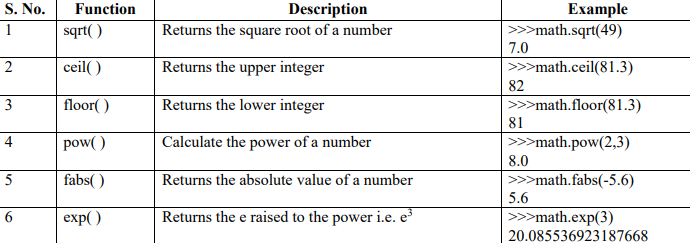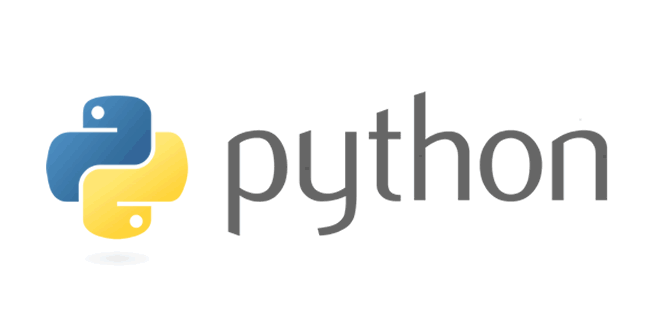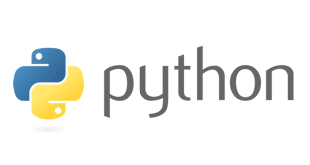| Chapter Name: | Function in Python [Chapter 05] |
| Class: | 11th |
| Subject: | Computer Science |
5.1 Definition: Function in Python
Functions are the subprograms that perform specific task. Functions are the small modules.
5.2 Types of Functions:
There are two types of functions in python:
- Library Functions (Built in functions)
- Functions defined in modules
- User Defined Functions

1.Library Functions in Python:
These functions are already built in the library of python.
For example: type( ), len( ), input( ) etc.
2. Functions defined in modules:
a. Functions of math module:
To work with the functions of math module, we must import math module in program
import math

b. Function in random module:
random module has a function randint( ).
- randint( ) function generates the random integer values including start and end values.
- Syntax: randint(start, end)
- It has two parameters. Both parameters must have integer values.
Example:
import random
n=random.randint(3,7)
3. User Defined Functions:
The syntax to define a function is:
def function-name ( parameters) :
#statement(s)
Where:
- Keyword def marks the start of function header.
- A function name to uniquely identify it. Function naming follows the same rules of
writing identifiers in Python. - Parameters (arguments) through which we pass values to a function. They are optional.
- A colon (:) to mark the end of function header.
- One or more valid python statements that make up the function body. Statements must
have same indentation level. - An optional return statement to return a value from the function.
Example:
def display(name):
print(“Hello ” + name + ” How are you?”)
5.3 Function Parameters:
A functions has two types of parameters:
- Formal Parameter: Formal parameters are written in the function prototype and function
header of the definition. Formal parameters are local variables which are assigned values from
the arguments when the function is called. - Actual Parameter: When a function is called, the values that are passed in the call are
called actual parameters. At the time of the call each actual parameter is assigned to the
corresponding formal parameter in the function definition.
Example:
def ADD(x, y): #Defining a function and x and y are formal parameters
z=x+y
print(“Sum = “, z)
a=float(input(“Enter first number: ” ))
b=float(input(“Enter second number: ” ))
ADD(a,b) #Calling the function by passing actual parameters
In the above example, x and y are formal parameters. a and b are actual parameters.
5.4 Calling the function: Functions in Python
Once we have defined a function, we can call it from another function, program or even the Python prompt. To call a function we simply type the function name with appropriate parameters.
Syntax:
function-name(parameter)
Example:
ADD(10,20)
Output:
Sum = 30.0
The return statement:
The return statement is used to exit a function and go back to the place from where it was
called.
There are two types of functions according to return statement:
- Function returning some value (non-void function)
- Function not returning any value (void function)
- Function returning some value (non-void function) :
Syntax:
return expression/value
Example-1: Function returning one value
def my_function(x):
return 5 * x
Example-2 Function returning multiple values:
def sum(a,b,c ):
return a+5, b+4, c+7
S=sum(2,3,4) # S will store the returned values as a tuple
print(S)
OUTPUT:
(7, 7, 11)
Example-3: Storing the returned values separately:
def sum(a,b,c):
return a+5, b+4, c+7
s1, s2, s3=sum(2, 3, 4) # storing the values separately
print(s1, s2, s3)
OUTPUT:
7 7 11 - Function not returning any value (void function) : The function that performs some
operationsbut does not return any value, called void function.
def message():
print(“Hello”)
m=message()
print(m)
OUTPUT:
Hello
None
5.5 Scope and Lifetime of variables:
Scope of a variable is the portion of a program where the variable is recognized. Parameters and variables defined inside a function is not visible from outside. Hence, they have a local scope.
There are two types of scope for variables:
- Local Scope
- Global Scope
1. Local Scope:
Variable used inside the function. It can not be accessed outside the function. In this scope, The lifetime of variables inside a function is as long as the function executes. They are destroyed once we return from the function. Hence, a function does not remember the value of a variable from its previous calls.
2. Global Scope:
Variable can be accessed outside the function. In this scope, Lifetime of a variable is the period throughout which the variable exits in the memory.
Example:
def my_func():
x = 10
print(“Value inside function:”,x)
x = 20
my_func()
print(“Value outside function:”,x)
OUTPUT:
Value inside function: 10
Value outside function: 20
Note: Here, we can see that the value of x is 20 initially. Even though the function my_func() changed
the value of x to 10, it did not affect the value outside the function. This is because the variable x inside the function is different (local to the function) from the one outside. Although they have same names, they are two different variables with different scope.
On the other hand, variables outside of the function are visible from inside. They have a global scope.
We can read these values from inside the function but cannot change (write) them. In order to modify the value of variables outside the function, they must be declared as global variables using the keyword global.
5.6 RECURSION:
Definition: A function calls itself, is called recursion.
5.6.1Python program to find the factorial of a number using recursion:
Program:
def factorial(n):
if n == 1:
return n
else:
return n*factorial(n-1)
num=int(input(“enter the number: “))
if num < 0:
print(“Sorry, factorial does not exist for negative numbers”)
elif num = = 0:
print(“The factorial of 0 is 1”)
else:
print(“The factorial of “,num,” is “, factorial(num))
OUTPUT:
enter the number: 5
The factorial of 5 is 120
5.6.2 Python program to print the Fibonacci series using recursion:
Program:
def fibonacci(n):
if n<=1:
return n
else:
return(fibonacci(n-1)+fibonacci(n-2))
num=int(input(“How many terms you want to display: “))
for i in range(num):
print(fibonacci(i),” “, end=” “)
OUTPUT:
How many terms you want to display: 8
0 1 1 2 3 5 8 13
5.7 lambda Function: Functions in Python
lambda keyword, is used to create anonymous function which doesn’t have any name.
While normal functions are defined using the def keyword, in Python anonymous functions are
defined using the lambda keyword.
Syntax:
lambda arguments: expression
Lambda functions can have any number of arguments but only one expression. The expression
is evaluated and returned. Lambda functions can be used wherever function objects are
required.
Example:
value = lambda x: x * 4
print(value(6))
Output:
24
In the above program, lambda x: x * 4 is the lambda function. Here x is the argument and x *4 is the expression that gets evaluated and returned.
Programs related to Functions in Python topic: Functions in Python
1. Write a python program to sum the sequence given below. Take the input n from the user.
Solution:
def fact(x):
j=1
res=1
while j<=x:
res=res*j
j=j+1
return res
n=int(input(“enter the number : “))
i=1
sum=1
while i<=n:
f=fact(i)
sum=sum+1/f
i+=1
print(sum)
2. Write a program to compute GCD and LCM of two numbers
Solution:
def gcd(x,y):
while(y):
x, y = y, x % y
return x
def lcm(x, y):
lcm = (x*y)//gcd(x,y)
return lcm
num1 = int(input(“Enter first number: “))
num2 = int(input(“Enter second number: “))
print(“The L.C.M. of”, num1,”and”, num2,”is”, lcm(num1, num2))
print(“The G.C.D. of”, num1,”and”, num2,”is”, gcd(num1, num2))
 Class Notes NCERT Solutions for CBSE Students
Class Notes NCERT Solutions for CBSE Students




